KFF COVID-19 Vaccine Monitor: What Do We Know About Those Who Want to “Wait and See” Before Getting a COVID-19 Vaccine?
The KFF COVID-19 Vaccine Monitor is an ongoing research project tracking the public’s attitudes and experiences with COVID-19 vaccinations. Using a combination of surveys and qualitative research, this project tracks the dynamic nature of public opinion as vaccine development and distribution unfold, including vaccine confidence and hesitancy, trusted messengers and messages, as well as the public’s experiences with vaccination.
Introduction
The latest KFF COVID-19 Vaccine Monitor reports that 31% of the public say that when an FDA-approved vaccine for COVID-19 is available to them for free, they will “wait until it has been available for a while to see how it is working for other people” before getting vaccinated themselves. This “wait and see” group is an important target for outreach and messaging, since they express some hesitancy about getting vaccinated, but will likely be much easier to convert from vaccine-hesitant to vaccine-acceptant than those who say they will “definitely not” get the vaccine or will get it “only if required” to do so. As reported in January, those in the “wait and see” category express high levels of concern about the safety and long-term effects of COVID-19 vaccines as well as a desire for more information about vaccine side effects and effectiveness. Most adults in this group (60%) do not yet know someone who’s been vaccinated for COVID-19, presenting an opportunity for them to learn more as more of their friends and family members get vaccinated.
This analysis examines the “wait and see” group in more detail, with a focus on their concerns about being vaccinated, the messages that resonate most, and the messengers they are likely to turn to for more information about COVID-19 vaccination. In particular, it looks at how attitudes within this group differ by partisanship and race/ethnicity, which should be helpful for those looking to target vaccine outreach and communication to groups like Republicans, Black adults, and Hispanic adults.
Key Takeaways: Overall
- Thirty-one percent of the public wants to “wait and see” how the COVID-19 vaccine is working for other people before getting vaccinated themselves. While they share a similar level of vaccine hesitancy, this group is not monolithic in their attitudes and beliefs. Within the “wait and see” group, people with different partisan identities and those belonging to different racial and ethnic groups express different levels of concern about the vaccine and may respond differently to messages and information.
Key Takeaways: Republicans
- Republicans and Republican-leaning independents (who make up just over a third of the “wait and see” group) are more likely to believe the seriousness of COVID-19 is being exaggerated in the news, and more likely to view vaccination as a personal choice. They are less likely to say they would be swayed by various messages and information that might increase their likelihood of getting vaccinated, though messages that emphasize protection from illness, the efficacy of the vaccine, and a return to normal life are most effective for this group. Taken together, these findings suggest that messages that focus on helping people make the right choice to protect their own health are more likely to resonate with Republican audiences than those that emphasize the seriousness of the pandemic or the need to get vaccinated for the collective good.
“Not sure there is anything that could be said. If it is proven effective and no side effects after a year or 2 of use I would no longer have concerns.”
- Republicans who want to “wait and see” are less likely than others to say they will turn to the CDC or state and local health departments for information when making decisions about whether to get vaccinated for COVID-19. Individual health care providers, pharmacists, and even family and friends are more likely to be effective messengers for this group rather than official public health agencies.
In their own words: From Republican respondents asked “If there is any person who would make you more likely to get vaccinated for COVID-19 if you found out that person got vaccinated, who is that person?”
“A best friend or very close family member.”
“No not any celebrity could change my mind. The only person that might be able to is my doctor who I trust if I can be told what is in the vaccine and how it works.”
Key Takeaways: Black and Hispanic adults
- Concern about getting sick with COVID-19 is high among Black and Hispanic adults in the “wait and see” group, but concerns about vaccine safety, efficacy, and side effects are high as well. A majority of Black and Hispanic adults in this group are concerned they might get COVID-19 from the vaccine, suggesting an opening for information to correct misperceptions about how the vaccine works among this group.
In their own words: From Black and Hispanic respondents asked “What is the biggest concern you have, if any, about getting a COVID-19 vaccine?”
“That I have allergic reactions or severe secondary reactions that prevent me from continuing with my life.”
“Being infected after taking it.”
“Knowing COVID is so devastating to human organs, I am concerned not only about the effectiveness of the vaccine but not so the long-term effects over years in the body… especially if it is needed on an ongoing basis.”
- Black and Hispanic adults who want to “wait and see” are generally more receptive than their White counterparts to messages and information that might increase vaccine acceptance. While the top messages for these groups are the same as for the public overall (that the vaccine is highly effective, will protect you from illness, and offers an opportunity to return to normal life), a wider range of messages may be effective with Black and Hispanic adults who initially express skepticism about the vaccine. In particular, Hispanic adults who want to “wait and see” are more responsive than their White or Black counterpart to hearing that the vaccine is available at no cost, and that a friend or family member or a health care provider they trust got vaccinated.
In their own words: From Black and Hispanic respondents asked “If there is one message or piece of information you could hear that would make you more likely to get vaccinated for COVID-19, what would it be?”
“That it is destroying the virus and not negatively affecting over 1% of those who have taken the shot.”
“Have a website or doctors explaining how exactly the vaccine is made and how it works in our body.”
“I am going to get the vaccine, I just will not be anywhere near the front of the line!”
- While health care providers are the top source that individuals across the board say they will turn to for information about COVID-19 vaccination, large shares of Black and Hispanic adults in the “wait and see” group also say they will turn to the CDC, state and local health departments, family and friends, and pharmacists for information. And although lower on the list of overall information sources, one-third of Black adults and three in ten Hispanic adults in the “wait and see” group say they’ll turn to a religious leader for information, suggesting another possible avenue for communicating with these groups about COVID-19 vaccines.
In their own words: From Black and Hispanic respondents asked “If there is any person who would make you more likely to get vaccinated for COVID-19 if you found out that person got vaccinated, who is that person?”
“My wife. She took the vaccine yesterday and she seems fine. If she continues doing well, I would seriously considering getting the vaccine earlier.”
“It would have to be my closest family and friends. I would take it if they took the vaccine.”
Profile Of The “Wait And See” Group
Demographically, those who want to “wait and see” are younger than other groups (29% are under age 30 and just 15% are ages 65 and over). They are a racially diverse group, with half (51%) identifying as White, 16% Black, and 19% Hispanic. They are also a politically diverse group; 42% identify as Democrats or Democratic-leaning independents, 36% identify as Republicans or Republican-leaning independents, and 14% are independents who don’t lean either way.
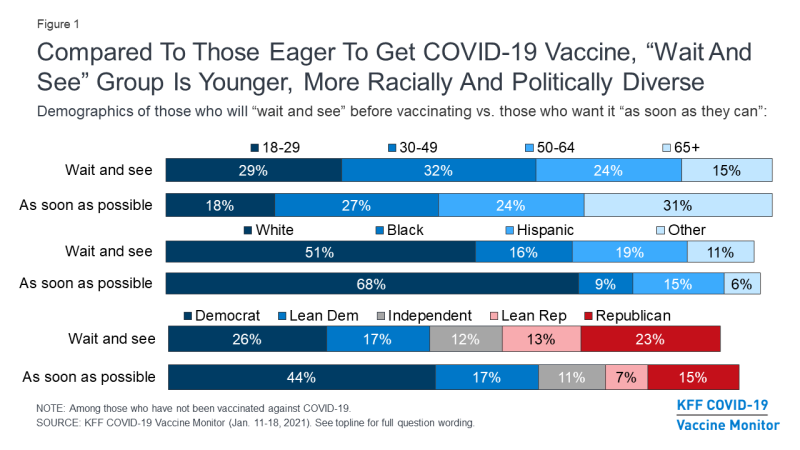
Figure 1: Compared To Those Eager To Get COVID-19 Vaccine, “Wait And See” Group Is Younger, More Racially And Politically Diverse
This group also holds a range of attitudes and beliefs when it comes to COVID-19 and vaccinations. About two-thirds (64%) say they are very or somewhat worried that they or a family member will get sick from the coronavirus (about the same share as among the public overall, but lower than the 79% among those who want the vaccine “as soon as possible”). Over half (54%) of those who want to wait and see say that getting vaccinated against COVID-19 is a personal choice, higher than the 21% who say so among the most vaccine-eager group, and compared to 44% who say so among the public overall.
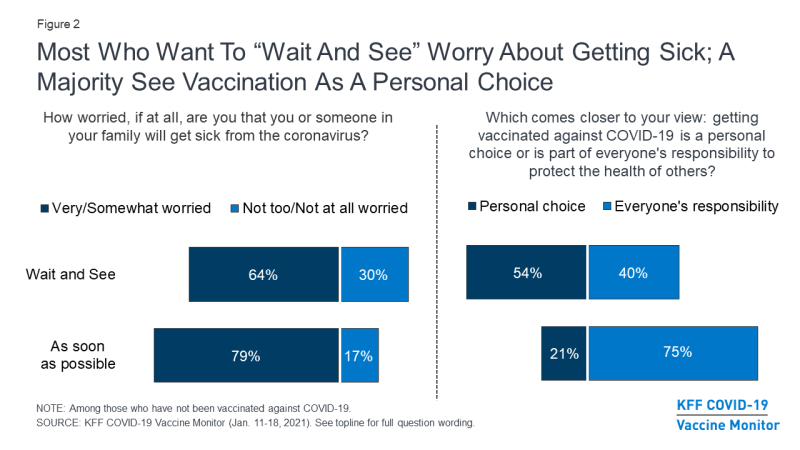
Figure 2: Most Who Want To “Wait And See” Worry About Getting Sick; A Majority See Vaccination As A Personal Choice
Partisan Differences Within The “Wait And See” Group
Previous Vaccine Monitor reports have shown that Republicans are more likely than Democrats and independents to say they will “definitely not” get vaccinated for COVID-19. This new analysis reveals that even among those who want to “wait and see,” there are differences between Republicans and Democrats in their attitudes and concerns related to the vaccines, as well as the messages they say are likely to motivate them and the messengers they’re likely to turn to. (For this analysis, those who identify as political independents but say the lean toward either the Democratic or Republican party are included with partisans.)
Republicans and Republican-leaning independents have vastly different attitudes toward the pandemic overall compared to Democrats and Democratic-leaning independents, even within the “wait and see” group. For example, about half (51%) of Republican leaners in this group say the seriousness of coronavirus is “generally exaggerated” in the news, compared to just 17% of Democratic leaners. Republicans are also significantly less likely than Democrats in this category to say they are worried that they or someone in their family might get sick from the coronavirus (51% vs. 76%). Further, about two-thirds (67%) of Republican leaners in the “wait and see” category believe that getting vaccinated for COVID-19 is a personal choice, while most Democratic leaners in this category (52%) say it’s part of everyone’s responsibility to protect the health of others.
| Table 1: Attitudes And Concerns About COVID-19 And COVID-19 Vaccinations By Party ID Among Those Who Want To “Wait And See” | |||
|
Total
“Wait and See”
|
Party ID |
||
| Democrats/ Democratic-leaning independents | Republicans/ Republican-leaning independents | ||
| Thinking about what is said in the news, in your view is the seriousness of coronavirus…? | |||
| Generally exaggerated | 34% | 17% | 51% |
| Generally correct | 44 | 50 | 36 |
| Generally underestimated | 18 | 30 | 9 |
| How worried, if at all, are you that you or someone in your family will get sick from the coronavirus? | |||
| Worried (NET) | 64% | 76% | 51% |
| Very worried | 27 | 34 | 18 |
| Somewhat worried | 37 | 42 | 33 |
| Not worried (NET) | 30 | 19 | 44 |
| Not too worried | 22 | 15 | 32 |
| Not at all worried | 8 | 4 | 12 |
| Which comes closer to your view: getting vaccinated against COVID-19 is…? | |||
| Is a personal choice | 54% | 43% | 67% |
| Is part of everyone’s responsibility to protect the health of others | 40 | 52 | 29 |
| NOTE: Among those who say they want to “wait and see” how the vaccine is working for other people before getting vaccinated themselves | |||
Within the “wait and see” group, levels of concern about the COVID-19 vaccines’ safety and effectiveness are similar across partisans. However, those who identify or lean Republican are much less likely than those who identify or lean Democrat to say that various messages and information would increase their likelihood of getting vaccinated for COVID-19. For example, among those who want to wait and see how the vaccine is working, half of Republicans say they would be more likely to get vaccinated if they heard that the vaccine will help protect them from getting sick from COVID-19, compared with three-quarters (76%) of Democrats. Similarly, Republicans in this category are half as likely as Democrats to say that hearing a health care provider they trust has gotten vaccinated would increase their likelihood of getting the vaccine (25% vs. 50%).
| Table 2: Response To Pro-Vaccine Messages And Information By Party ID Among Those Who Want To “Wait And See” | |||
| Percent who say that hearing each of the following would make them more likely to get vaccinated: |
Total
“Wait and See”
|
Party ID | |
| Democrats/ Democratic-leaning independents | Republicans/ Republican-leaning independents | ||
| The vaccines have been shown to be highly effective in preventing illness from COVID-19 | 66% | 74% | 64% |
| The vaccine will help protect you from getting sick from COVID-19 | 62 | 76 | 50 |
| The quickest way for life to return to normal is for most people to get vaccinated | 61 | 75 | 48 |
| Millions of people have already safely been vaccinated for COVID-19 | 51 | 66 | 38 |
| We need people to get vaccinated to get the U.S. economy back on track | 48 | 58 | 36 |
| There is no cost to get the vaccine | 38 | 49 | 26 |
| A doctor or health care provider you trust has gotten the vaccine | 38 | 50 | 25 |
| A close friend or family member got vaccinated for COVID-19 | 37 | 46 | 24 |
| NOTE: Among those who say they want to “wait and see” how the vaccine is working for other people before getting vaccinated themselves | |||
Conversely, a smaller share of Republican leaners compared with Democratic leaners within the “wait and see” group say that hearing that some people experience short-term side effects like pain or fever from the COVID-19 vaccine would make them less likely to get vaccinated (38% vs. 56%).
| Table 3: Response To Negative Vaccine Messages And Information By Party ID Among Those Who Want To “Wait And See” | |||
| Percent who say that hearing each of the following would make them less likely to get vaccinated: |
Total
“Wait and See”
|
Party ID | |
| Democrats/ Democratic-leaning independents | Republicans/ Republican-leaning independents | ||
| A small number of people have experienced a serious allergic reaction to the COVID-19 vaccine | 60% | 62% | 58% |
| Some people were experiencing short-term side effects like pain or fever from the COVID-19 vaccine | 50 | 56 | 38 |
| You will need to continue to wear a mask and practice social distancing even after getting vaccinated | 31 | 26 | 32 |
| You had to receive two doses of the vaccine several weeks apart | 26 | 28 | 24 |
| NOTE: Among those who say they want to “wait and see” how the vaccine is working for other people before getting vaccinated themselves | |||
Those who want to wait and see how the COVID-19 vaccine works for others also report a somewhat different set of trusted sources for vaccine information depending on their partisan leanings. While health care providers are the source that people across partisan affiliations say they are most likely to turn to when making decisions about whether to get vaccinated, significant differences exist when it comes to some other sources. Specifically, among the “wait and see” group, those who identify as Republicans or lean that way are much less likely than those who identify or lean Democrat to say they are likely to turn to the U.S. Centers for Disease Control and Prevention (52% vs. 79%) or their state or local health department (45% vs. 73%) when making vaccine-related decisions.
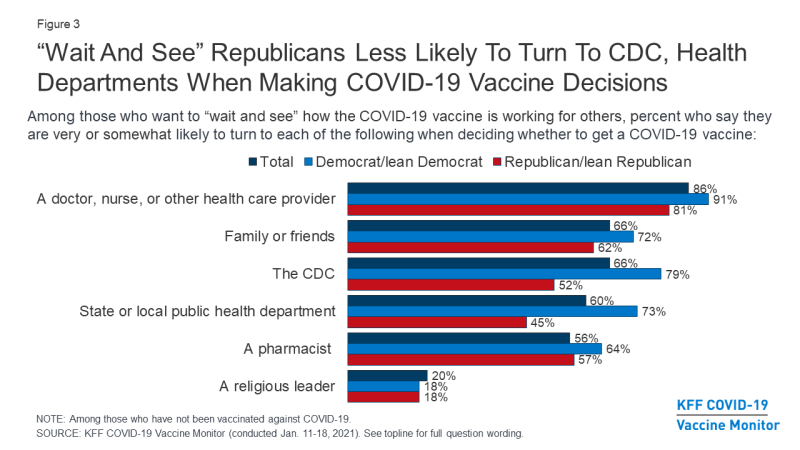
Figure 3: “Wait And See” Republicans Less Likely To Turn To CDC, Health Departments When Making COVID-19 Vaccine Decisions
Differences By Race And Ethnicity Within The “Wait And See” Group
The KFF COVID-19 Vaccine Monitor has previously reported that Black and Hispanic adults are among those most likely to say they want to “wait and see” how the vaccine is working for others before getting vaccinated themselves. This analysis further reveals that Black and Hispanic adults who feel this way express somewhat different attitudes and concerns about COVID-19 vaccinations compared to their White counterparts in the “wait and see” group.
Previous KFF research has found that Black and Hispanic adults overall are less likely to trust doctors, hospitals, and the health care system compared to White adults, and that for Black adults, lower levels of trust are associated with lower levels of COVID-19 vaccine acceptance. This new COVID-19 Monitor analysis finds that Black adults in the “wait and see” category are also less trusting of the health care system in general; a majority (57%) say they trust the health care system just “some of the time” or “almost none of the time” to do what is right for them and their community, compared to 43% of White adults in this category. Hispanic adults who want to “wait and see” are more divided, with about half saying they trust the health care system “almost all” or “most” of the time (51%) and the other half saying they trust it just “some” or “almost none” of the time (49%).
| Table 4: Trust Of The Health Care System By Race/Ethnicity Among Those Who Want To “Wait And See” | ||||
| Percent who say they trust the health care system to do what is right for them and their community… |
Total
“Wait and See”
|
Race/Ethnicity | ||
| Black | Hispanic | White | ||
| Almost all/Most of the time (NET) | 54% | 43% | 51% | 55% |
| Almost all of the time | 19 | 22 | 17 | 19 |
| Most of the time | 35 | 20 | 35 | 36 |
| Some/Almost none of the time (NET) | 45 | 57 | 49 | 43 |
| Some of the time | 37 | 40 | 40 | 38 |
| Almost none of the time | 8 | 17 | 9 | 5 |
| NOTE: Among those who say they want to “wait and see” how the vaccine is working for other people before getting vaccinated themselves | ||||
Reflecting the disproportionate impact of the pandemic on people of color in the United States, concern about getting sick from the virus is high among Black and Hispanic adults in the “wait and see” group, with about three-quarters saying they are “very” or “somewhat” worried that they or someone in their family will get sick from coronavirus. In fact, Hispanic adults are more than twice as likely as White adults in this group to say they are “very worried” about this possibility (43% vs. 19%).
In addition to this heightened level of personal concern, more than four in ten Black adults (43%) and Hispanic adults (45%) in the “wait and see” group view getting vaccinated against COVID-19 as part of everyone’s responsibility to protect the health of others, compared to a clear majority (61%) of White adults in this group who say getting vaccinated is a “personal choice.”
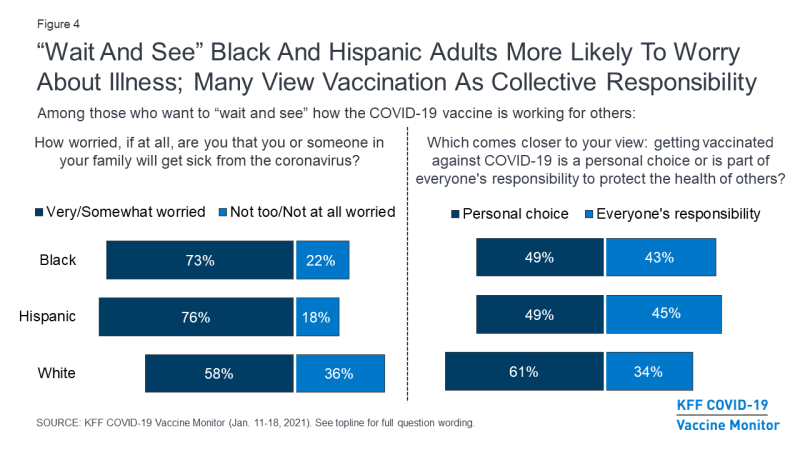
Figure 4: “Wait And See” Black And Hispanic Adults More Likely To Worry About Illness; Many View Vaccination As Collective Responsibility
While Black and Hispanic adults in the “wait and see” group express higher levels of concern about getting sick from the coronavirus, they also express higher levels of concerns related to the vaccine. For example, vaccine-hesitant Black and Hispanic adults are more likely than hesitant White adults to say they are “very concerned” that they might experience serious side effects from the vaccine (55%, 47%, and 34%, respectively). Black and Hispanic adults in this group are also significantly more likely than their White counterparts to say they’re “very concerned” that the vaccines are not as safe or not as effective as they are said to be. Notably, about six in ten Hispanic adults (61%) and Black adults (59%) in the “wait and see” group say they are at least somewhat concerned that they may get COVID-19 from the vaccine (including about three in ten in each group who say they are “very” concerned), much higher than among their White counterparts.
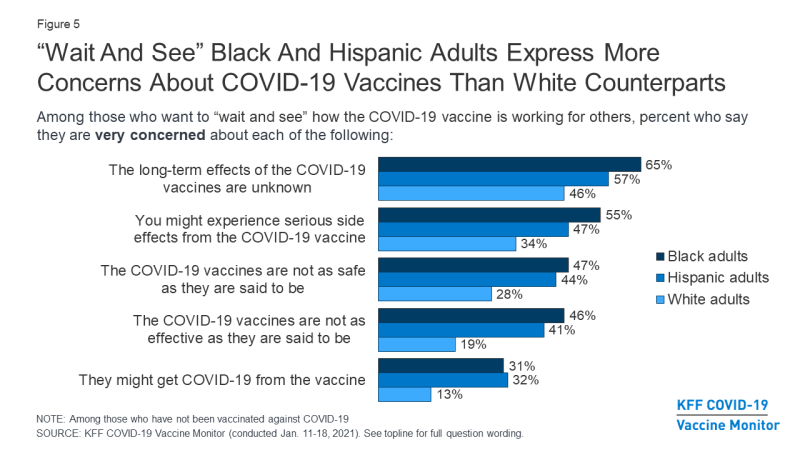
Figure 5: “Wait And See” Black And Hispanic Adults Express More Concerns About COVID-19 Vaccines Than White Counterparts
Among those in the “wait and see” category, Black adults are somewhat more responsive than White adults to certain pro-vaccine messages and information – including messages that vaccination is the best way for things to return to normal, to get the economy back open, and that millions have already safely been vaccinated. However, Black adults are also more likely than White adults to say that hearing about side effects would make them less likely to get vaccinated.
Similarly, Hispanic adults are more responsive than White adults in the “wait and see” category towards messaging that encourage vaccinations. However, they are also more likely than their White counterparts to say that hearing about side effects and needing to get two doses of the vaccine would make them less likely to get vaccinated.
Despite these differences, it’s worth noting that the messages that resonate most with Black and Hispanic adults who are hesitant to get a COVID-19 vaccine are the same ones that appear to be most effective with the public overall – messages that emphasize that the vaccine is highly effective, offers protection from illness, and provides the quickest way for life to return to normal.
| Table 5: Responses To Pro-Vaccine Messaging And Information By Race/Ethnicity Among Those Who Want To “Wait And See” | ||||
| Percent who say that hearing each of the following would make them more likely to get vaccinated: |
Total
“Wait and See”
|
Race/Ethnicity | ||
| Black | Hispanic | White | ||
| The vaccines have been shown to be highly effective in preventing illness from COVID-19 | 66% | 66% | 74% | 62% |
| The vaccine will help protect you from getting sick from COVID-19 | 62 | 64 | 80 | 54 |
| The quickest way for life to return to normal is for most people to get vaccinated | 61 | 68 | 79 | 53 |
| Millions of people have already safely been vaccinated for COVID-19 | 51 | 58 | 68 | 42 |
| We need people to get vaccinated to get the U.S. economy back on track | 48 | 58 | 60 | 43 |
| There is no cost to get the vaccine | 38 | 36 | 53 | 33 |
| A doctor or health care provider you trust has gotten the vaccine | 38 | 47 | 54 | 30 |
| A close friend or family member got vaccinated for COVID-19 | 37 | 42 | 56 | 29 |
| NOTE: Among those who say they want to “wait and see” how the vaccine is working for other people before getting vaccinated themselves | ||||
| Table 6: Response To Negative Vaccine Messages And Information By Race/Ethnicity Among Those Who Want To “Wait And See” | ||||
| Percent who say that hearing each of the following would make them less likely to get vaccinated: |
Total
“Wait and See”
|
Race/Ethnicity | ||
| Black | Hispanic | White | ||
| A small number of people have experienced a serious allergic reaction to the COVID-19 vaccine | 60% | 66% | 61% | 55% |
| Some people were experiencing short-term side effects like pain or fever from the COVID-19 vaccine | 50 | 58 | 58 | 39 |
| You will need to continue to wear a mask and practice social distancing even after getting vaccinated | 31 | 29 | 36 | 27 |
| You had to receive two doses of the vaccine several weeks apart | 26 | 30 | 35 | 20 |
| NOTE: Among those who say they want to “wait and see” how the vaccine is working for other people before getting vaccinated themselves | ||||
Across racial and ethnic groups, those in the “wait and see” category are most likely to say they will turn to a doctor, nurse or other health care provider for information when deciding whether to get vaccinated for COVID-19. In fact, one-third of Black adults in this group say they have already asked a doctor or other health care professional for information about the vaccine, somewhat higher than among vaccine-hesitant White adults (18%). Hispanic adults in this group (13%) are significantly less likely than their Black counterparts to say they’ve reached out to a health care provider for more information about the vaccine. This may reflect the fact that Hispanics in the U.S. overall have lower rates of health insurance coverage and face greater barriers to accessing health care compared to other groups.
Looking at potential sources of information beyond health care providers, both Black and Hispanic adults are more likely than White adults in the “wait and see” group to say they are at least somewhat likely to turn to the CDC, their state or local public health department, or a religious leader for vaccine information. While health care workers will undoubtedly be a key source of information for those who express some hesitancy towards the COVID-19 vaccine, the CDC, public health departments, and religious leaders are also positioned to be effective messengers in promoting vaccination among Black and Hispanic communities.
| Table 7: Likely Sources Of COVID-19 Vaccine Information by Race/Ethnicity Among Those Who Want To “Wait And See” | ||||
| Percent who say, when deciding whether to get a COVID-19 vaccine, they are very or somewhat likely to turn to each of the following for information: |
Total
“Wait and See” |
Race/Ethnicity | ||
| Black | Hispanic | White | ||
| A doctor, nurse, or other health care provider | 86% | 90% | 90% | 82% |
| Family or friends | 66 | 61 | 73 | 65 |
| The CDC | 66 | 78 | 76 | 56 |
| Your state or local public health department | 60 | 73 | 77 | 47 |
| A pharmacist | 56 | 64 | 59 | 54 |
| A religious leader such as minister, pastor, priest, or rabbi | 20 | 35 | 28 | 14 |
| Have you asked a doctor or other health care professional for information about the COVID-19 vaccine, or not? | ||||
| Yes | 18% | 33% | 13% | 18% |
| No | 81 | 67 | 87 | 82 |
| NOTE: Among those who say they want to “wait and see” how the vaccine is working for other people before getting vaccinated themselves | ||||
